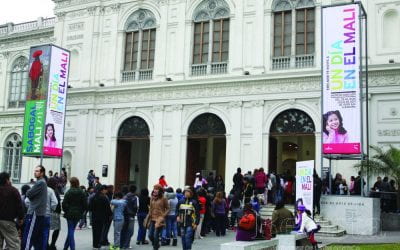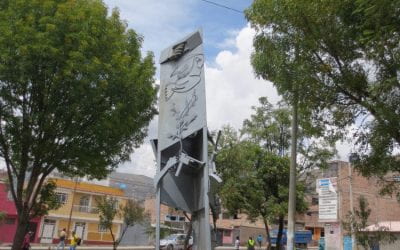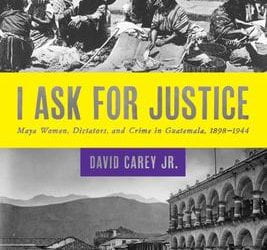The Nu LatAm Sound
Dancing in the Sun with Animal Chuki
Inside underground Peruvian discothèques, a duo known as Animal Chuki forms part of that sound inherent to the Latin American flavor and groove that they carry in their blood. In a hot room filled with rhythmic music that sweats clean and crisp jungle water, a thick atmosphere is enjoyed by a transnational youth that smokes porritos (herb) and dances. Later in the night, they walk out into the urban streets to eat anticuchos, heart of cattle, seasoned with special flavors, and drink chicha morada, a rich punch made from purple corn. Grant C. Dull, aka El G, has been developing this Nu LatAm Sound at ZZK Records in neighboring Buenos Aires, Argentina, for the past five years.
When understanding the Nu LatAm Sound, El G believes “It is essential to look at what’s going on in modern-day Peru. Undergoing a sort of digital renaissance, the country’s rich tradition of cumbias and folklore are being transformed by the newer generations with all the splendor and psychedelia that made Peru a focal point of new sounds in [the] 60s, 70s and 80s.”
Andrea Campos was inspired on bus rides from her home in San Isidro to the Universidad de Lima. Campos says, “A nanny in my house influenced me into listening to Peruvian music like Pintura Roja and Anita Santibañes. As I got older, I jumped to electronic music by Diplo and Daft Punk. Through Animal Chuki, I am trying to relay a spiritual message through this combination.” Upon graduating with a degree in communications, Campos began to work by day at an advertising agency, DDB/Fahrenheit, and at night she developed the second half of Animal Chuki. Now, at age 23, Campos develops the integrated graphics of the duo and helps to explore the cocktail of folk and electronic dance music that has become the signature sound of the band.
Daniel Valle-Riestra, also 23, works in sound design for all types of audiovisual projects from his home in La Molina miles from the city. A mellow but focused musician, Valle-Riestra developed a following on SoundCloud and was asked by El G to produce a remix for the Argentine artist, La Yegros. Valle-Riestra says, “I am constantly searching for methods to make my living through my passion for music. Since working in office environments has not allowed me to grow as a person, I try to dedicate all my time and energy to music. When I heard La Yegros’ voice, I knew I wanted to join this effort.”
Remix: https://soundcloud.com/animalchuki/viene-de-mi-animal-chuki-remix
El G, a dandy and bon vivant, met with the group in Lima recently to discuss their future. They spoke at length in local cevicherías over chicharrón de pescado mixto, leche de tigre, helado de lúcuma and tuna sours. El G says that, “Tropical bass and digital cumbia seem to be sweeping the city of Lima right now. It is a community robust with exceptional music, food and libation.” He continues, “In Miraflores, we walked at night past ancient Incan huacas snuggled against modern lofts on quiet tree-lined streets. The coastline at Barranco and the Olivar Park in San Isidro are some of the nicest natural spots I’ve enjoyed in all of Latin America.”
Peru is just a part of the story. Ondatrópica and Quantic in Colombia are playing their part. Other members of The Nu LatAm Sound include La Yegros, Chancha via Circuito, Miss Bolivia, King Coya, El Remolón, Meridian Brothers, Frikstailers, Tremor, Bomba Estereo, Fauna, Super Guachin, Largatijeando and Douster. El G has been so inspired by the movement’s camaraderie that he is producing a series for television and a documentary film to document the era. Hashtagged as #TNLS (The Nu LatAm Sound), El G is collaborating with creatives and investors to bring the project to film festivals worldwide.
Film Trailer: http://zzkrecords.com/thenulatamsound/
In the foreword of Ted Mallon’s The Journey Toward Masterful Philanthropy, Jungian Bernice Hill writes, “I think of Ted’s journey as similar to that of Quechuan shamans in Peru. These brave souls, called alto misayogs, feel they have been ordered by the gods to go into the mountains to encounter lightning. If they are struck by this intense electrical energy and survive, they believe they have undergone a profound initiation. They return with certain powers, having communed with the gods. They bear, however, some essential message for the life and transformation of their community.”
When I listen to Animal Chuki in the Intelatin sound studio in southern California, I don’t stop to question whether alto misayogs exist or whether they chase lightning. I simply see them in my mind, returning home to the Andes and playing Animal Chuki while they dance in the sun.
An Intelatin sampler of #TNLS: http://bit.ly/1nHxEWG
Fall 2014, Volume XIV, Number 1
Sergio C. Muñoz is a Mexican artist working in the surf culture of southern California at Intelatin. His latest project is called Gamma Rae in the Americas. It is crafted for the benefit of DACA Dreamers in the USA. Twitter: @Intelatin
Related Articles
The Violence of the VIP Boxes
English + Español
In Peru, the upper class does not like to mix with those they consider different or inferior. Their maids on the beaches south of Lima are not allowed to swim in club pools and, sometimes, not even in the ocean. The VIP boxes at sports and theater events maintained by the government are a public display of a private practice that reproduces in the public sphere the worst aspect of private hierarchical structuring.
Peace and Reconciliation
English + Español
Eleven years have gone by since the Peruvian Truth and Reconciliation Commission presented its final report. The report reconstructed the history of many cases of massacres, tortures, murders and other serious crimes. At the same time, it contributed an interpretation of the…
I Ask for Justice: Maya Women, Dictators, and Crime in Guatemala, 1898–1944
On May 10, 2013, General Efraín Ríos Montt sat before a packed courtroom in Guatemala City listening to a three-judge panel convict him of genocide and crimes against humanity. The conviction, which mandated an 80-year prison sentence for the octogenarian, followed five weeks of hearings that included testimony by more than 90 survivors from the Ixil region of the department of El Quiché, experts from a range of academic fields, and military officials.




